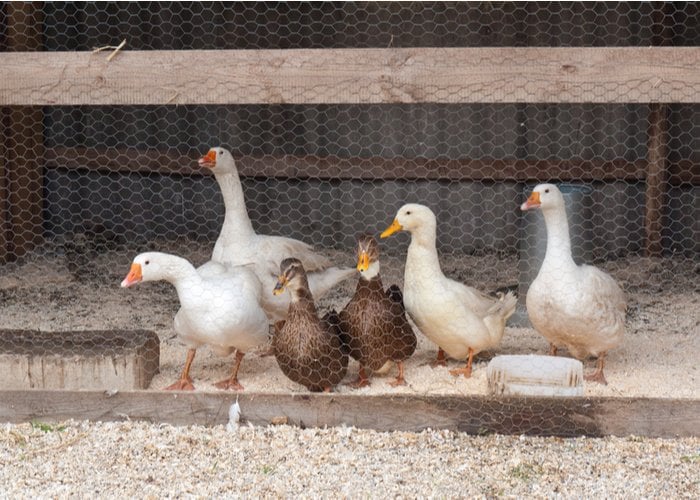Are you looking for duck breeds that can’t fly from their coop?
While it’s true that all domestic ducks can achieve flight in some capacity, a few duck breeds are too heavy or short-winged to maintain a few inches off the ground.
Here are ten duck breeds that can’t fly and will be content to remain with your backyard flock.
10 Duck Breeds That Can’t Fly
Pekin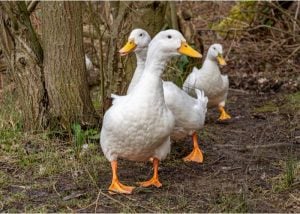
ThePekin duckis a popular choice with homesteaders for various reasons.
Their friendly and social personalities make them great family pets or welcome companions to free-range in the backyard.
Pekins are easy to care for, and their low maintenance needs are perfect for beginner flock owners.
They are also a wonderful dual-purpose breed, providing prolific egg-laying production and a generous portion of meat that can be dressed for the table.
Thestocky-bodied Pekin weighs 8 or 9 pounds, preventing them from flying.
When it comes to flight, they can manage a few inches off the ground for a short distance, but nothing more significant than that.
Moulard
TheMoulard– or Mule Duck – is often raised for meat, thanks to itshefty 15-pound body, low-fat ratio, and rich liver.
These birds are quiet and prefer to stay close to familiar territory rather than roam or attempt to escape the coop.
Though the Moulard’s parentage includes breeds well known for their flight (MallardsandMuscovies), it is too heavy to take flight.
RELATED:Can Duck Breeds Mix?
Ancona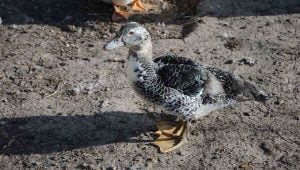
TheAnconais beloved by homesteaders for its delicious meat and reliable egg-laying abilities.
It’s one of the heavier layers, producing up to 280 eggs annually.
This quiet, stocky duck breed makes wonderful free-range companions in the backyard, enjoying your company.
At the same time, they forage for snails and insects.
Anconas are hardy birds, adapting well to any climate, regardless of extreme heat or cold temperatures.
Due to itssturdy 6 pounds of body weight,this duck can’t achieve flight for much more than a hop and a skip across the yard.
Buff Orpington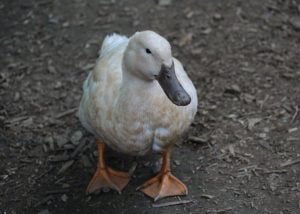
TheBuff Orpingtonmight be a delicious duck for the dinner table.
Still, it has such a docile and amiable personality that it is often kept as a family pet.
This blond duck breed started in England in the 1900s and quickly became popular due to its easygoing nature.
Buff Orpington hens make wonderful broody mothers and can lay over 200 eggs annually.
These ducks are laid back, calm, and don’t startle easily, making them an ideal choice for urban homesteaders in small spaces.
This breed istoo heavy to fly并且更喜欢挂out and socialize.
Cayuga
The Cayuga is a beautiful emerald green duck developed for meat and egg production.
Due to its dark feathers, it’s difficult to dress for the table, requiring time-consuming skinning methods to prep the bird.
When the Pekin became the preferred duck of choice for meat, the Cayuga was kept instead for showing purposes, thanks to its gorgeous iridescent plumage.
Cayuga ducks are an extremely cold hardy breed, weathering harsh winters well.
They can lay up to 150 eggs annually, with an eye-catching array of colors, from pale gray to slate to black.
Since these birds were originally bred for meat, they aretoo heavy to fly,choosing to show off their pretty colors while they chill with the flock.
RELATED:Caring For Ducks During Winter
Indian Runner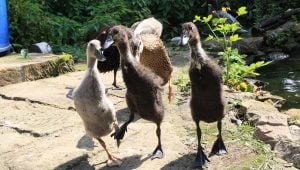
Indian Runnerducks are most recognizable by their shape, like a bowling pin or a wine bottle.
With long, tapered bodies, they are more suited to running than flying.
Theirwings are too shortto keep their bodies in the air.
These high-strung ducks are an old breed, originating in Indonesia and spreading throughout Europe in the 1800s.
Indian Runners are dual-purpose ducks, providing 3 to 5 pounds of meat, and laying over 300 eggs annually, though hens exhibit no broodiness.
This breed is resilient against disease, hardy in hot and cold weather, and are avid foragers who keep backyard pests in check.
Silver Appleyard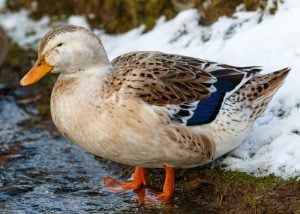
TheSilver Appleyardwas initially bred in England during the early 1900s.
Their purpose was to lay a bounty of eggs, provide an aesthetically pleasing flock that foraged the backyard and offer plenty of delicious, hearty meat for the kitchen.
Due to their mottled brown and white striped feathers, Silver Appleyards do well in the show ring for exhibition.
Hens are generous layers, producing up to 260 large eggs per year.
This breed makes for a sturdy bird with ablocky body,weighing 6 to 8 pounds.
Though they like to be free-range and forage for their dinner, these ducks cannot fly the coop.
Welsh Harlequin
TheWelsh Harlequinis an attractive bird with light brown and cream-colored feathers.
Another breed originating from England, these ducks have only been around since the 1950s.
Still, they are quickly gaining popularity due to their pretty plumage, incredible egg-laying abilities, and tasty meat.
Hens are wonderful broody mothers, laying 300 to 350 eggs per year.
Males are known for their high libido, requiring only one drake to service an entire flock of females.
Welsh Harlequins are calm, quiet, and friendly ducks that don’t startle easily and make for easy handling, especially for children.
Though these duckscan’t truly fly, they canachieve a few inches off the groundbefore they decide to return to solid footing again.
Rouen
Originating from France, theRouenresembles a Mallard in coloring.
It is often raised for rich and savory meat, a friendly family pet, and exhibitions, thanks to its colorful feathers.
These birds are laid back and easygoing.
They are one of the quieter breeds of duck, making them ideal for urban homesteaders seeking a flock that keeps the noise level down.
Though they are not the greatest layers, producing anywhere from 50 to 120 eggs per year, they do have a beautiful blue or green tint to their shell.
Rouens are prized for their delicious meat.
Males can tip the scales at10 pounds,producing lean, light-flavored meat that is pretty easy to dress.
Since these heavy birds don’t fly well and prefer to stay close to the ground instead.
Crested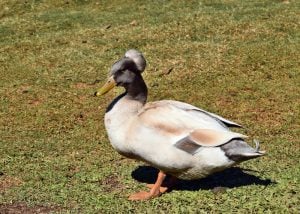
Crested duckshave been around for years, dating back as early as the 1800s when they were accepted into the American Standard of Perfection.
White is the most common coloring, but black is available as well.
Though they are a dual-purpose breed, they are most often kept as family pets due to their amusing personalities and appearance.
Hens are reliable layers, producing up to 200 eggs annually with moderate broodiness.
Their broad bodies are lighter than other meat ducks, but they can still provide up to5 pounds of meat.
Crested ducks have been known to experienceneurological issues, including a tottering walk or an inability to get up.
However, these ducks cannot sustain flight, so they stay in the coop.
Reason Why Some Duck Breeds Can’t Fly
Some duck breeds are unable to fly due to their physical characteristics and breeding history.
One of the main physical characteristics that affect a duck’s ability to fly isits body size and weight.
Domesticated duckshave been bred to be larger and heavier than their wild counterparts, which can make it difficult for them to take off and fly.
Additionally, some breeds have been bred to have shorter wings and smaller flight muscles, further reducing their ability to fly.
Another factor that affects a duck’s ability to fly isits habitat.
Domesticated ducks are typically kept in pens or enclosures, which limits their ability to fly and may result in reduced flight ability over time.
In contrast, wild ducks have access to open water and natural habitats that allow them to fly and maintain their flight ability.
重要的是要注意,并非所有的驯化duck breeds are unable to fly.
Some breeds, such as theMuscovy duck,are capable of short bursts of flight and can even roost in trees.
However, these breeds are the exception rather than the rule, and most domesticated duck breeds have limited flight ability.
FAQs about Duck Breeds That Can’t Fly
What are the benefits of keeping ducks that can’t fly?
One of the main benefits of keeping ducks that can’t fly is that they are generally easier to contain and keep in a specific area.
This can be especially beneficial for backyard or small-scale farming operations.
Additionally, ducks that can’t fly may be less likely to escape and become lost or injured.
Because of this, they can be suitable for backyard or small-scale farming, as they are generally easier to contain and manage.
They can provide a source of meat and eggs or simply be kept as pets.
Are there any disadvantages to keeping ducks that can’t fly?
Flightless ducks may be more vulnerable to predators as they are unable to fly away to safety.
They may only protect themselves by seeking shelter in a secure coop or pen at night.
Or they can stay close to other ducks or animals that can provide protection.
Additionally, some duck breeds that can’t fly may have health issues or require special care due to their body size and shape.
Can ducks that can’t fly be kept with other types of poultry?
Yes, ducks that can’t fly can be kept with other types of poultry, such as chickens or turkeys.
However, it’s important to make sure that the housing and feeding requirements are appropriate for all types of poultry.
Ducks that can’t fly may require special housing requirements, such as a secure coop or pen that is protected from predators.
RELATED:Duck Housing And Duck Coops
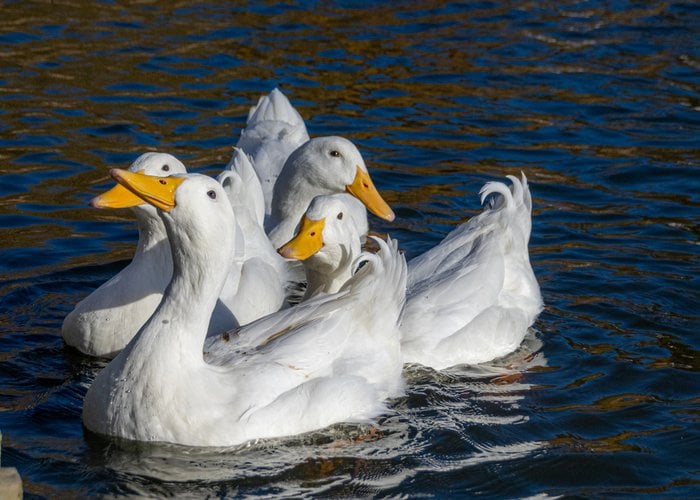
Duck Breeds That Can’t Fly: Before You Go…
Ducks are a versatile, entertaining, and productive addition to any backyard flock.
Their quirky personalities, egg laying, and meat quality ensure that there is the perfect duck for every homesteader’s needs.
These ten duck breeds that can’t fly will remain in your coop, so you can rest easy that they will stay put!
Interested to learn more about different duck breeds?
Check out our recommended reads below!
